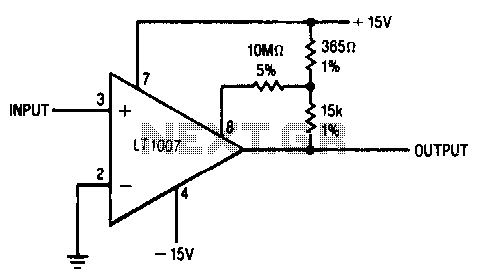
Microvolt-comparator-with-hysteresis

Positive feedback to one of the nulling terminals creates approximately 5 μV of hysteresis. The output can sink 16 mA; the input offset voltage is typically changed to less than 5 μV because of the feedback.
In this circuit, the implementation of positive feedback to a nulling terminal is essential for enhancing the stability and performance of the system. The introduction of approximately 5 μV of hysteresis serves to mitigate the effects of noise and improve the reliability of the output signal. This hysteresis ensures that the circuit remains in a defined state even in the presence of small variations in the input signal.
The output stage of the circuit is capable of sinking up to 16 mA, indicating that it can effectively handle significant load currents without compromising performance. This characteristic is particularly useful in applications where the circuit must drive external components or interfaces.
Furthermore, the feedback mechanism plays a crucial role in minimizing the input offset voltage. Typically, the input offset voltage is adjusted to less than 5 μV due to the feedback process. This low offset voltage is vital for precision applications, ensuring that the output accurately reflects the intended input signal without introducing significant errors.
Overall, this circuit design demonstrates a robust approach to managing hysteresis and offset voltage through positive feedback, ensuring reliable operation across various conditions.Positive feedback to one of the nulling terminals creates approximately 5 p.V of hysteresis. The output can sink 16 mA; the input offset voltage is typically changed less tban 5 p.V because of the feedback.
In this circuit, the implementation of positive feedback to a nulling terminal is essential for enhancing the stability and performance of the system. The introduction of approximately 5 μV of hysteresis serves to mitigate the effects of noise and improve the reliability of the output signal. This hysteresis ensures that the circuit remains in a defined state even in the presence of small variations in the input signal.
The output stage of the circuit is capable of sinking up to 16 mA, indicating that it can effectively handle significant load currents without compromising performance. This characteristic is particularly useful in applications where the circuit must drive external components or interfaces.
Furthermore, the feedback mechanism plays a crucial role in minimizing the input offset voltage. Typically, the input offset voltage is adjusted to less than 5 μV due to the feedback process. This low offset voltage is vital for precision applications, ensuring that the output accurately reflects the intended input signal without introducing significant errors.
Overall, this circuit design demonstrates a robust approach to managing hysteresis and offset voltage through positive feedback, ensuring reliable operation across various conditions.Positive feedback to one of the nulling terminals creates approximately 5 p.V of hysteresis. The output can sink 16 mA; the input offset voltage is typically changed less tban 5 p.V because of the feedback.